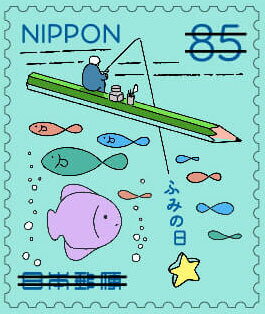Stamp: Letter Writing Day 2025 (Japan 2025)
Letter Writing Day 2025 (Japan 2025)
23 May (Japan ) within release Letter Writing Day 2025 goes into circulation Stamp Letter Writing Day 2025 face value 85 Japanese yen
| Stamp Letter Writing Day 2025 in catalogues | |
|---|---|
| Colnect codes: | Col: JP 2025.05.23-01e |
Stamp is square format.
Stamp from Mini-SheetAlso in the issue Letter Writing Day 2025:
- Mini Sheet - Letter Writing Day 2025 face value 10*85;
- Mini Sheet - Letter Writing Day 2025 face value 10*110;
- Stamp - Letter Writing Day 2025 face value 85;
- Stamp - Letter Writing Day 2025 face value 85;
- Stamp - Letter Writing Day 2025 face value 85;
- Stamp - Letter Writing Day 2025 face value 85;
- Stamp - Letter Writing Day 2025 face value 85;
- Stamp - Letter Writing Day 2025 face value 110;
- Stamp - Letter Writing Day 2025 face value 110;
- Stamp - Letter Writing Day 2025 face value 110;
- Stamp - Letter Writing Day 2025 face value 110;
- Stamp - Letter Writing Day 2025 face value 110;
Stamp Letter Writing Day 2025 it reflects the thematic directions:
Angling (from Old English angol, meaning "hook") is a fishing technique that uses a fish hook attached to a fishing line to tether individual fish in the mouth. The fishing line is usually manipulated with a fishing rod, although rodless techniques such as handlining also exist. Modern angling rods are usually fitted with a fishing reel that functions as a cranking device for storing, retrieving and releasing out the line, although Tenkara fishing and traditional cane pole fishing are two rod-angling methods that do not use any reel. The fish hook itself can be additionally weighted with a denser tackle called a sinker, and is typically dressed with an appetizing bait (i.e. hookbait) to attract and entice the fish into swallowing the hook, but sometimes an inedible fake/imitation bait with multiple attached hooks (known as a lure) is used instead of a single hook with edible bait. Some type of bite indicator, such as a float, a bell or a quiver tip, is often used to relay underwater status of the hook to the surface and alert the angler of a fish's presence.
A fish is any member of a group of animals that consist of all gill-bearing aquatic craniate animals that lack limbs with digits. They form a sister group to the tunicates, together forming the olfactores. Included in this definition are the living hagfish, lampreys, and cartilaginous and bony fish as well as various extinct related groups. Tetrapods emerged within lobe-finned fishes, so cladistically they are fish as well. However, traditionally fish are rendered obsolete or paraphyletic by excluding the tetrapods (i.e., the amphibians, reptiles, birds and mammals which all descended from within the same ancestry). Because in this manner the term "fish" is defined negatively as a paraphyletic group, it is not considered a formal taxonomic grouping in systematic biology. The traditional term pisces (also ichthyes) is considered a typological, but not a phylogenetic classification. The earliest organisms that can be classified as fish were soft-bodied chordates that first appeared during the Cambrian period. Although they lacked a true spine, they possessed notochords which allowed them to be more agile than their invertebrate counterparts. Fish would continue to evolve through the Paleozoic era, diversifying into a wide variety of forms. Many fish of the Paleozoic developed external armor that protected them from predators. The first fish with jaws appeared in the Silurian period, after which many (such as sharks) became formidable marine predators rather than just the prey of arthropods. Most fish are ectothermic ("cold-blooded"), allowing their body temperatures to vary as ambient temperatures change, though some of the large active swimmers like white shark and tuna can hold a higher core temperature. Fish are abundant in most bodies of water. They can be found in nearly all aquatic environments, from high mountain streams (e.g., char and gudgeon) to the abyssal and even hadal depths of the deepest oceans (e.g., gulpers and anglerfish). With 33,100 described species, fish exhibit greater species diversity than any other group of vertebrates. Fish are an important resource for humans worldwide, especially as food. Commercial and subsistence fishers hunt fish in wild fisheries (see fishing) or farm them in ponds or in cages in the ocean (see aquaculture). They are also caught by recreational fishers, kept as pets, raised by fishkeepers, and exhibited in public aquaria. Fish have had a role in culture through the ages, serving as deities, religious symbols, and as the subjects of art, books and movies.


